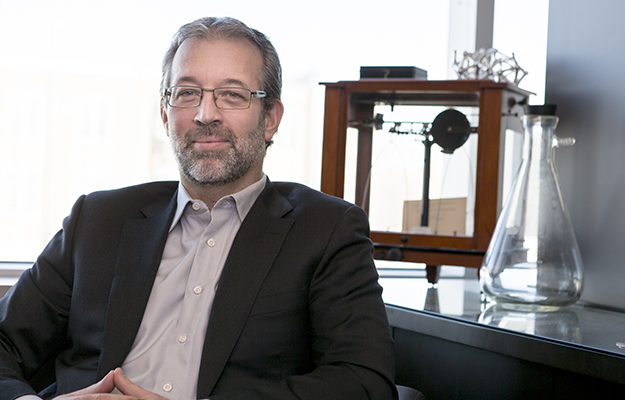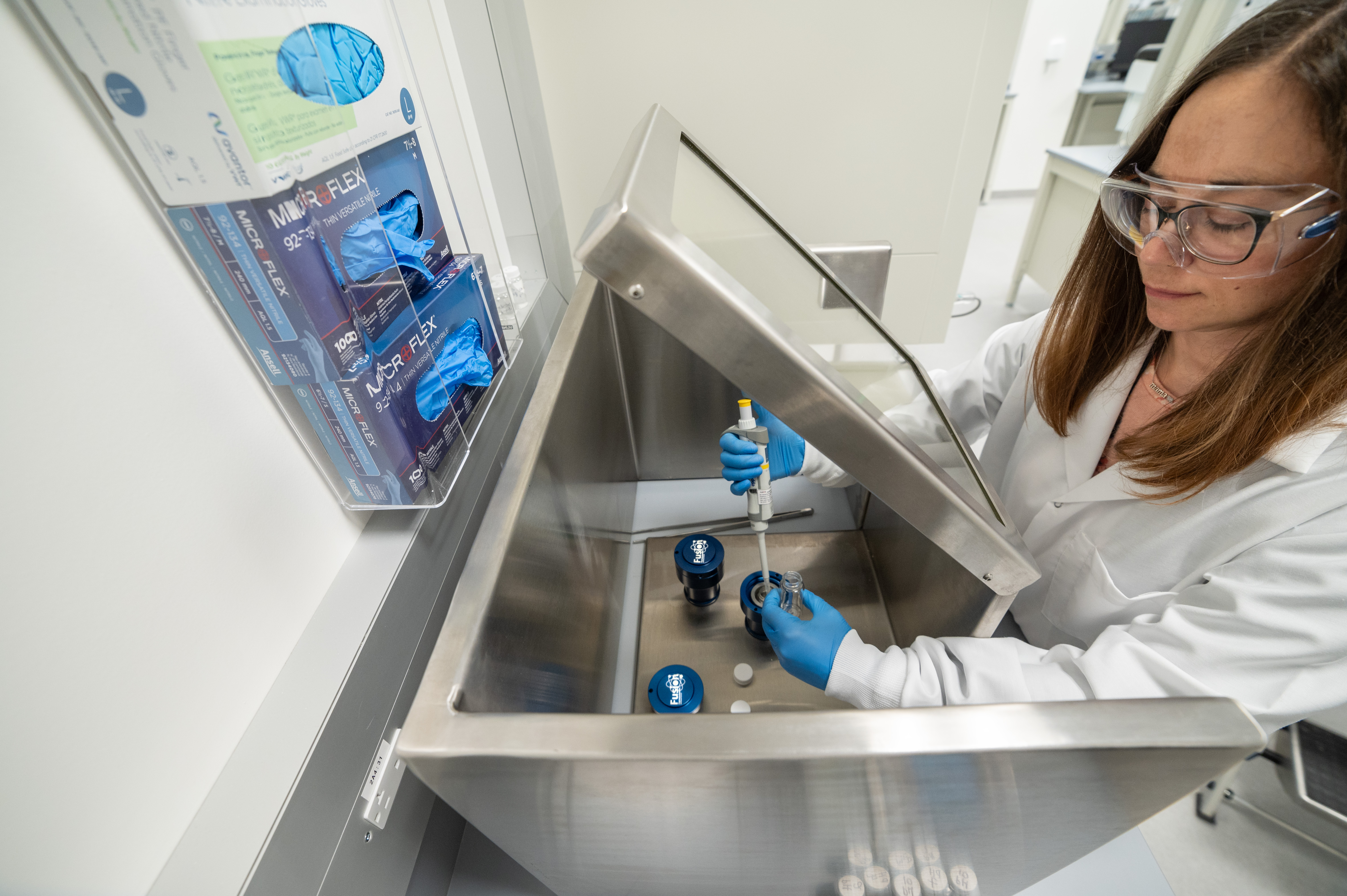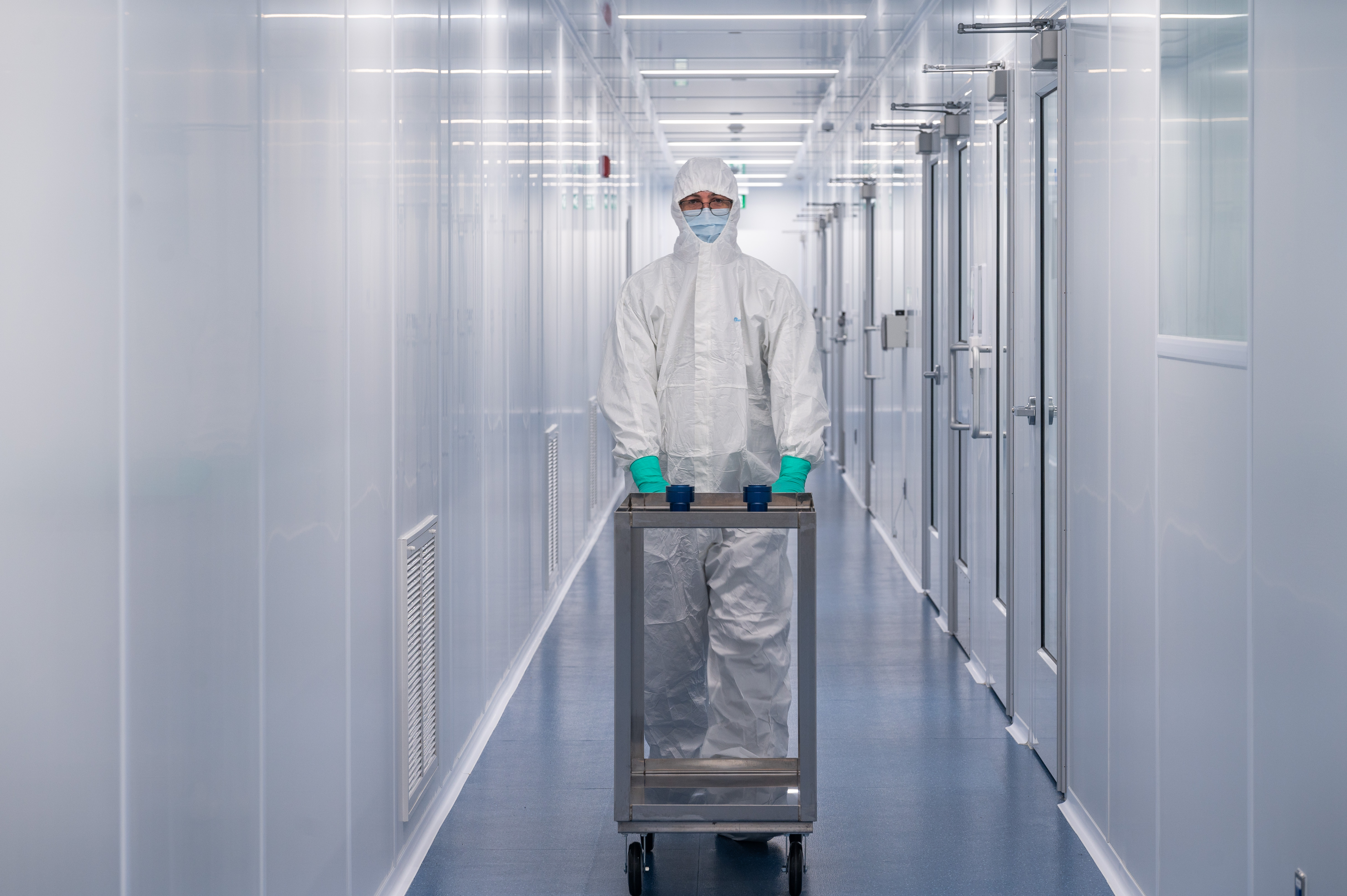Meet John Valliant, the scientist-entrepreneur behind one of the largest acquisitions in Canadian university history

John Valliant and his team create next-generation cancer treatments. He's also training a new generation of scientists and opening doors for other researchers working to turn their discoveries into real-world solutions.
BY Jay Robb
September 9, 2024
Just days after making entrepreneurial history, John Valliant was at an event celebrating entrepreneurs at McMaster University.
Everyone at the Made at Mac event knew that Fusion Pharmaceuticals — the cancer therapy and diagnostics company Valliant founded in 2016 — was being acquired by British pharma giant AstraZeneca. The $2 billion (US) acquisition was one of the largest deals of its kind in Canadian university history.
Like Valliant, many of the emerging and established entrepreneurs at McMaster are finding ways to translate their cutting-edge research into real-world solutions.
Unlike him, they’re building companies in an entrepreneurship ecosystem that didn’t exist when Valliant was an undergraduate student at McMaster more than 30 years ago.
“Today’s students and faculty are far more entrepreneurial than I ever was at their age. You can feel their drive and enthusiasm,” says Valliant, a chemistry professor.
“There’s no shortage of brilliant people, innovative technologies and ideas at McMaster. The evolution of that ecosystem’s been nothing short of amazing.”
Today, there’s the McMaster Entrepreneurship Academy, with its Professor Entrepreneurship Fellowship and Innovation Matchmaking program. University-backed incubators like The Forge, The Clinic and MACcelerate. Programs like the Master of Biomedical Innovation — the first graduate health-care entrepreneurship program of its kind in Canada.
What Valliant had instead was perfect timing, many mentors and inexhaustible tenacity.
A chemistry student at Canada’s nuclear university
McMaster was already recognized as Canada’s nuclear university when Valliant arrived from Kingston, Ont. as an undergraduate student in science.
McMaster was home to Canada’s first mass spectrometer, an instrument used to separate isotopes, molecules and molecular fragments, and the first university-based nuclear research reactor in the Commonwealth.
Valliant found his calling in his final year of undergrad, when two legends in the chemistry department — professors Russell Bell and Colin Lock — received major federal research funding to advance the study of medical isotope chemistry.
“The idea that new chemistry done with medical isotopes could ultimately lead to better diagnostics and treatments blew my mind,” says Valliant. “It was fascinating and incredibly exciting.
“Bell and Lock were great mentors with bold visions who helped everyone around them think bigger. Based on their passion for chemistry and the fact they were good people, I was excited about the opportunity to start my graduate work with them”

Valliant completed his PhD at McMaster and a postdoctoral fellowship at Harvard University and the Massachusetts Institute of Technology before returning to McMaster as an assistant professor in 1999.
He quickly earned acclaim: He was named the Tier 1 Canada Research Chair in Medical Isotopes and Molecular Imaging Probes, one of Canada’s Top 40 Under 40; and was part of a team of recipients of the Brockhouse Canada Prize for Interdisciplinary Research in Science and Engineering.
Valliant was one of the first researchers Maureen MacDonald met following her appointment in 2017 as Dean of McMaster’s Faculty of Science. Gianni Parise, at the time the faculty’s Associate Dean of Research and External Relations, told MacDonald: “John approaches research in a whole different way and he’s going to do something great.”
The walls between discovery, new treatments and patients
In addition to focusing on research and training students, Valliant would also try to knock down the wall that stood between academia, patient need and the private sector — notably, the radiopharmaceutical industry.
“I loved the science we were doing in our lab, but I knew it would never get to patients,” he says.
This is where Valliant’s experience as a postdoc came into play. In the U.S., he’d seen firsthand how cutting-edge science and commercialization could run in tandem.
This wasn’t yet happening to any great extent in the field of radiopharmaceuticals research at Canadian universities. Turning scientific discoveries into clinical trials and new lifesaving treatments for cancer patients was challenging and slow.
Valliant was frustrated because cancer patients couldn’t afford to wait. “We needed to do better by them and their families.” He’s always been energized by deeply personal stories about cancer: “That’s all the motivation you need to get up in the morning and keep doing the work.”

He could’ve turned back from the wall and left it for someone else to bring down. But that wasn’t really an option. “I learned to be relentless on certain things.”
And professors are paid to think and share knowledge with others, Valliant says.
“The core responsibility of any professor is to push the boundaries in their field … We have an obligation to share our knowledge and help society.”
Plus, there is what might be the best advice Valliant ever got: Always have a big and bold idea in the top drawer of your desk.
A bold idea for better cancer treatments
Valliant sketched out his big, bold idea on a napkin at the Phoenix, a McMaster pub, with Robert Sutherland, who at the time was leading the commercialization group at the Ontario Institute for Cancer Research (OICR): What if they built a made-at-McMaster centre that brought together smart people with the drive to develop and commercialize radiopharmaceuticals for better cancer diagnosis and treatment? A centre that could punch through the wall by bringing together industry, government and academic partners?
The OICR offered to invest in the centre — if there was matching federal government and private sector funding.
So Valliant partnered with a team that included Sutherland; OICR founding president Tom Hudson; John Babich, a leader in radiopharmaceutical research; Peter Robertson, a leader at GE Healthcare Canada; and a team from McMaster that made a successful pitch to the Government of Canada’s Centres of Excellence for Commercialization and Research (CECR) program.
The federal government came through with the first of three rounds of funding, and the Centre for Probe Development and Commercialization (CPDC) opened its doors in 2008.
The wall was starting to come down.
The CPDC — a not-for-profit private company still located at McMaster — grew into a global leader in advancing probe discovery, development and clinical research while also providing a reliable supply of radiopharmaceuticals. Sutherland became chairman of the board and Valliant served as the centre’s founding CEO and ran it like a startup.

Innovative centre at McMaster helps launch four biotech startups
Since then, the CPDC has put McMaster, Ontario and Canada at the forefront of the rapidly growing medical isotope and radiopharmaceutical sector.
It’s brought new radiopharmaceuticals into clinical development, in turn supporting several clinical trials across North America and Europe. And those trials could soon lead to new diagnostics and treatments for cancer patients.
The centre also helped launch four Canadian radiopharmaceutical companies — Canprobe in 2011, ARTMS in 2013, Fusion in 2017 and AtomVie Global Radiopharma in 2022.
AstraZeneca sees deal as major step in transforming cancer care
Valliant became the founding CEO of Fusion Pharmaceuticals. The CPDC team secured $46 million (US) in Series A funding for Fusion, with $105 million in Series B private financing two years later. Fusion went public in 2020, being listed on the Nasdaq as a Canadian biotech company.
Fusion began construction of a 27,000-square-foot radiopharmaceutical manufacturing facility at McMaster Innovation Park. The facility, which opened in 2023, was once used by Westinghouse to manufacture appliances.

Fusion created the capacity to produce up to 100,000 doses of life-saving radioconjugates. Combining manufacturing with R&D on new therapeutics called targeted alpha therapies, it ultimately led to AstraZeneca’s acquisition and Fusion’s place in McMaster’s record books.
In announcing the deal for the Canadian company, AstraZeneca said it “marks a major step forward in delivering on its ambition to transform cancer treatment and outcomes for patients by replacing traditional regimes like chemotherapy and radiotherapy with more targeted treatments.”
Training the next generation of nuclear medicine scientists
Nine days after that announcement, Valliant was at the Made at Mac entrepreneurship event. He went alone, but was quick to credit everyone who had played a role in making history at McMaster.
“You have to invite people who aren’t going to agree with everything you say, who’ll challenge your perspective, freely share their successes and failures, and help you do better,” he says.
Karin Stephenson was there at the beginning of Valliant’s journey: The first undergraduate thesis student to join Valliant’s research group and one of the first CPDC employees.
“John called me up and asked if I was free for breakfast. When John does that, you know something’s up.”
Today, Stephenson is the Director of Nuclear Research and Education Support at McMaster and the Chief Science Officer with the Canadian Nuclear Isotope Council.
“John would give his students these amazing opportunities that lifted all of us up.”
Professors tend to proudly keep tabs on the students who pass through their research groups. If that record is like a family tree, Valliant has an entire forest.
Paul Schaffer was one of the first graduate students to work with Valliant. Today, he’s the head of TRIUMF’s Life Sciences division and Chief Technical Officer for ARTMS, a radioisotope production technology firm that was acquired by Telix Pharmaceuticals Limited in April.
“John’s trained and mentored so many students over the years that it’s easily six degrees of separation,” says Stephenson. “If you haven’t been trained by John, chances are you’ll wind up hiring or working with one of his proteges or you’ll run into them at conferences.”
In 2022, Fusion joined with Mitacs and the Faculty of Science to launch the Fusion Pharmaceuticals Training Program, led by Professor Sam Sadeghi.
The program has graduate students splitting their time between McMaster’s Nuclear Science Research Building and Fusion’s research and development facilities at the McMaster Innovation Park.
Could one of those McMaster graduate students go on to become the CEO of another Canadian radiopharmaceutical company that discovers new ways of treating untreatable cancers for patients with the rarest and most aggressive of cancers?
Count on it, says Valliant.
Medical isotopes 101
Medical isotopes are the cornerstone of nuclear medicine, using radioactive sources, atoms and molecules to diagnose and treat disease. Worldwide, more than 40 million medical procedures are carried out each year using radioactive isotopes, with around 36 million for diagnostic nuclear medicine and four million for radiation therapy.
According to the Canadian Nuclear Association, isotopes are used in approximately 760,000 diagnostic procedures and 76,000 radiation therapy procedures for Canadians each year.
Here’s one example of how made-in-Canada radioisotopes are saving lives: the cure rate for cervical cancer’s increased from 25 to 75 per cent.
About the McMaster Nuclear Reactor
The McMaster Nuclear Reactor was the first university-based research reactor in the Commonwealth when it came online in 1959. Today, the reactor is the world’s leading supplier of two lifesaving medical isotopes — iodine-125 and holmium-166.
The reactor team produces and ships isotopes around the world, providing treatment for more than 70,000 cancer patients every year.
About Fusion Pharmaceuticals
A cancer therapy and diagnostics company with research and manufacturing operations at the McMaster Innovation Park. Fusion Pharmaceuticals, recently acquired by AstraZeneca, develops next-generation radioconjugates as precision medicine.
Injected intravenously, radioconjugates deliver potent medical radioisotope “smart bombs” directly to cancer cells without collateral damage to nearby healthy cells.


